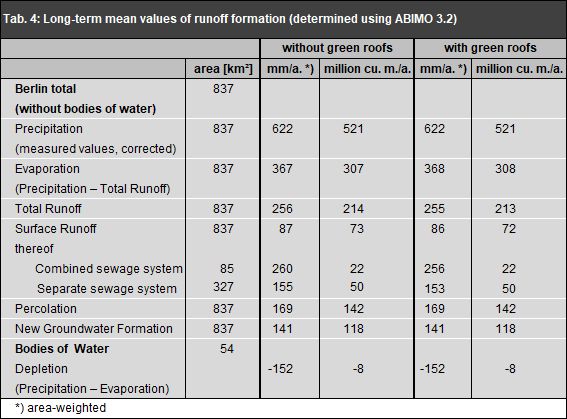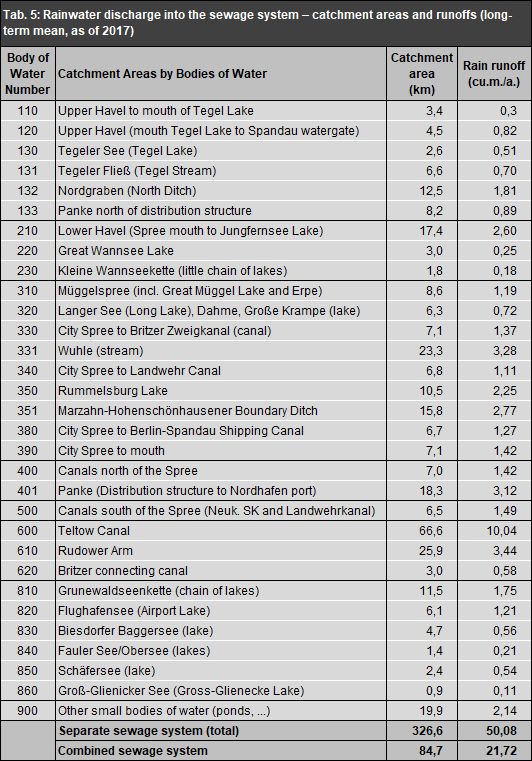The map of Total Runoff (Map 02.13.3) shows that the total runoff for the highly impervious inner-city areas (inside the Urban-Rail Ring Line) is in the range of 350-450 mm/a; the values are even higher in the very dense centre-city area and in some industrial areas. Here, only about 150 mm/a (Map 02.13.5) evaporate, referenced to the precipitation measurements (at 1 m height), which are about 10-15 % less than ground-level precipitation. The less densely built-up areas in the outskirts of the city show runoffs of 250-350 mm/a. Compared with the runoffs of the pervious areas on the outskirts, or in the areas surrounding Berlin, where the values are approx. 150 mm/a, Berlin can be considered an island of greatly increased runoff. The reduction of the evaporation due to imperviousness and lack of vegetation – as shown in the map Evaporation (Map 02.13.5) – leads to runoff double or triple the natural runoff.
Groundwater net consumption (depletion) occurs only in a few areas characterized by low precipitation and simultaneously low depth to the water table, which produces negative runoff formation values, since here, the vegetation is fed by groundwater, and can evaporate more of it than can subsequently be supplied by precipitation.
The map of Surface Runoff (02.13.1) shows that in the inner-city areas connected to the wastewater/sewage system, an average of about 250 mm/a is fed to the wastewater system. The peak values are higher than 400 mm/a. In outlying areas connected to the wastewater/sewage system, the values are around 100 mm/a.
The Percolation map (02.13.2) shows a picture that is surprising at first glance: It shows inner-city percolation from precipitation of about 120 mm/a – roughly the same as for woodlands. The non-densely built-up residential areas on the outskirts show considerably higher percolation capacities of 200 mm/a; the values for the areas with low degrees of connection to the wastewater/sewage system in fact climb to 300 mm/a. In the residential areas with no connection to the sewage system, all the runoff percolates into the soil, averaging about 300-350 mm/a and reaching maximum values of over 400 mm/a.
In conclusion, the following can be stated:
- The effect of the reduced permeability of the soil caused by the high degree of impervious coverage in the inner city is to a large extent counteracted by the effect of reduced evaporation, so that inner-city percolation capacities are higher than initially assumed, and reach almost “natural” levels.
- The extent of impervious coverage is only secondarily important for percolation capacity; of primary importance is the actual degree of connection to the wastewater/sewage system. The type of impervious coverage, i.e. the differing percolation capacity of the various surface-cover types, also plays an important role.
- The reduction of evaporation due to impervious coverage in low-density areas with simultaneously low degrees of connection to the wastewater/sewage system causes the percolation capacities in these areas to be the highest, and approximately double those of “natural” percolation.
In the Glacial Spillway area, the percolation water can percolate directly and completely to the groundwater surface, due to the permeable sands which overlay the groundwater. Here, the calculated percolation is equal to new groundwater formation. On the Barnim and Teltow ground-moraine plateaus however, loamy and thus poorly water-permeable layers overlay the mostly confined groundwater. Here, the deeply cut streams are fed largely by confined groundwater or via sandy and hence permeable layers in the ground moraine. Only that part of the percolation water (calculated percolation) not passed on by the tributaries can be considered true recharging of the main aquifer beneath the ground moraine. These water quantities reach the glacial spillway area as sub-surface runoff. The break-down is respectively dependent on the concrete hydrogeological conditions. A comparison of the runoffs measured and calculated shows that e.g. in the catchment area of the Neuenhagen Mill Stream, some 35 % the calculated percolation percolates sub-surface to the glacial spillway area, while the Tegel Creek passes virtually all of the runoff it receives from the percolation of its catchment area on at the surface. A map of new groundwater formation has also been developed on the basis of the percolation-water rates determined by means of the ABIMO model (Map 02.17 as of 2019).
The evaporation from bodies of waters surfaces, which are not shown on the map, is approx. 152 mm/a more than the precipitation which falls on them, so that Berlin’s bodies of water lose a total of approx. 8 million cu. m. of water per year due to evaporation.
For some very highly impervious areas, no information was available as to whether the rainwater from them is passed on via the wastewater system. For this reason, runoff for these areas has been certified in the maps as percolation. However, the degree of impervious coverage and the amount of runoff makes it seem in some cases improbable that the water actually percolates into the soil. As a result, it is likely that the share of surface runoff tends to be underestimated, and that that of percolations overestimated.
With the aid of the area sizes of the reference surfaces, the runoff volumes could also be calculated and then totalled (cf. Tab. 4).



